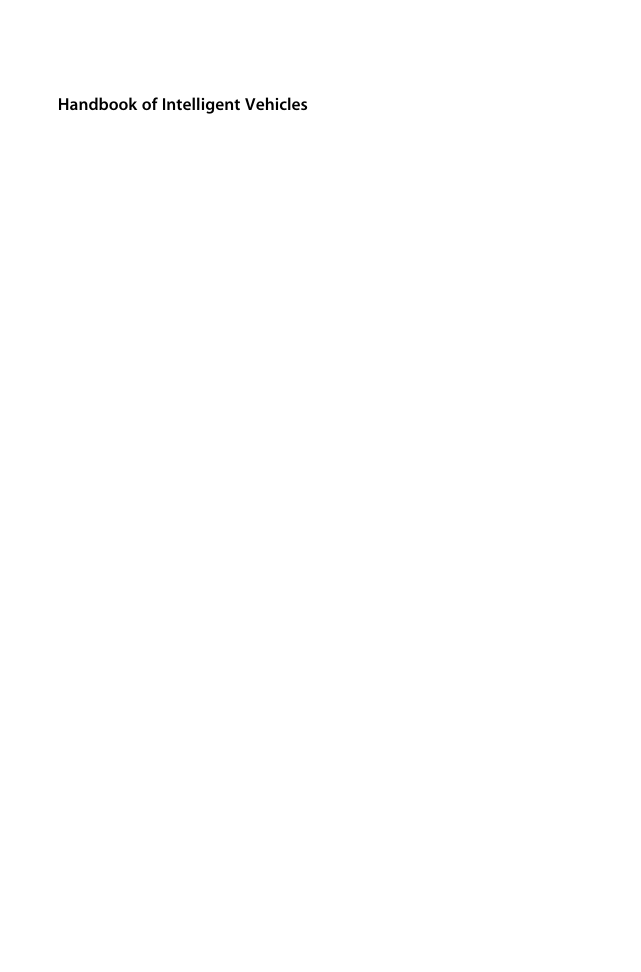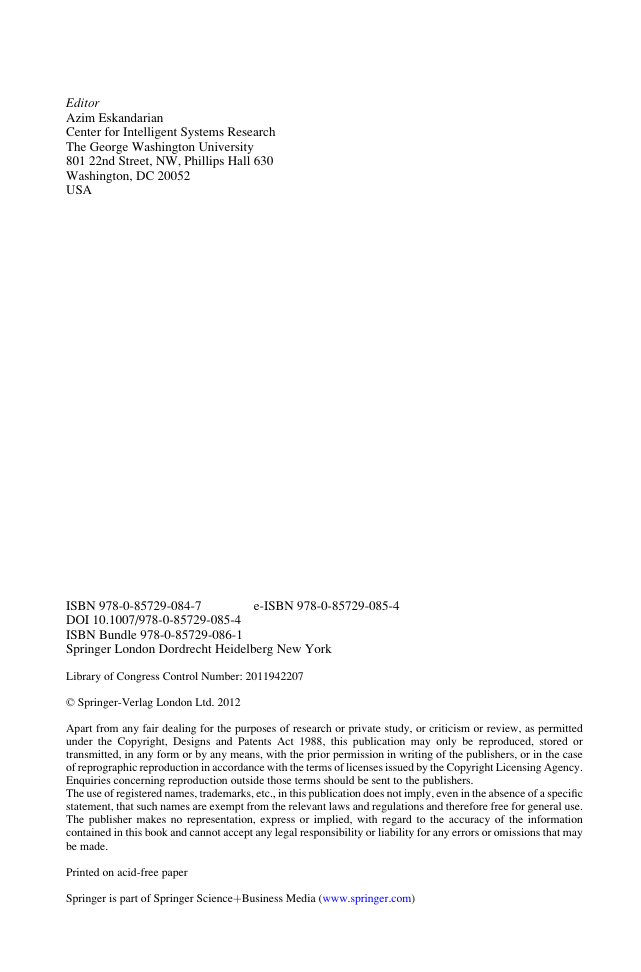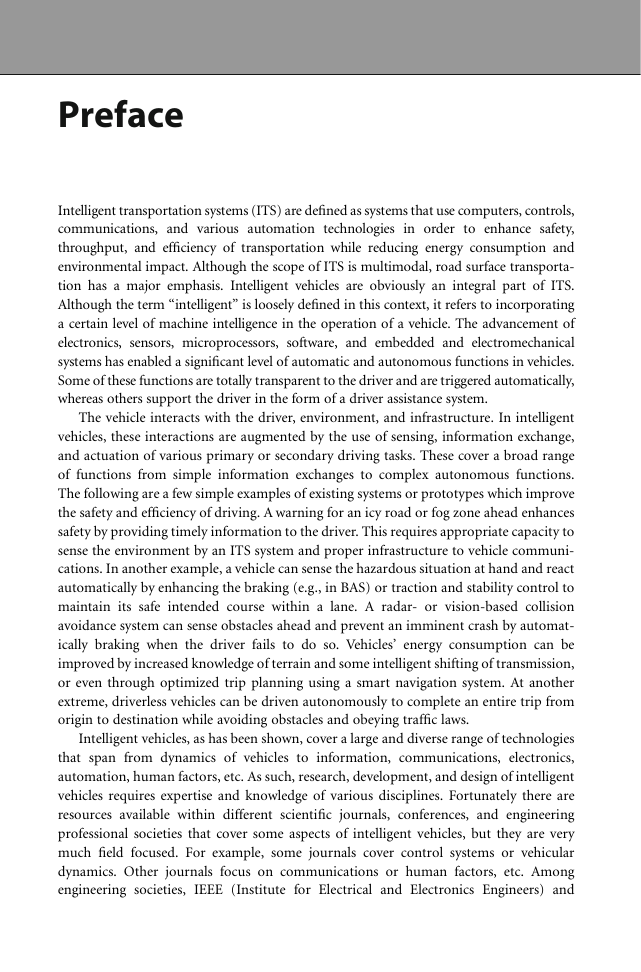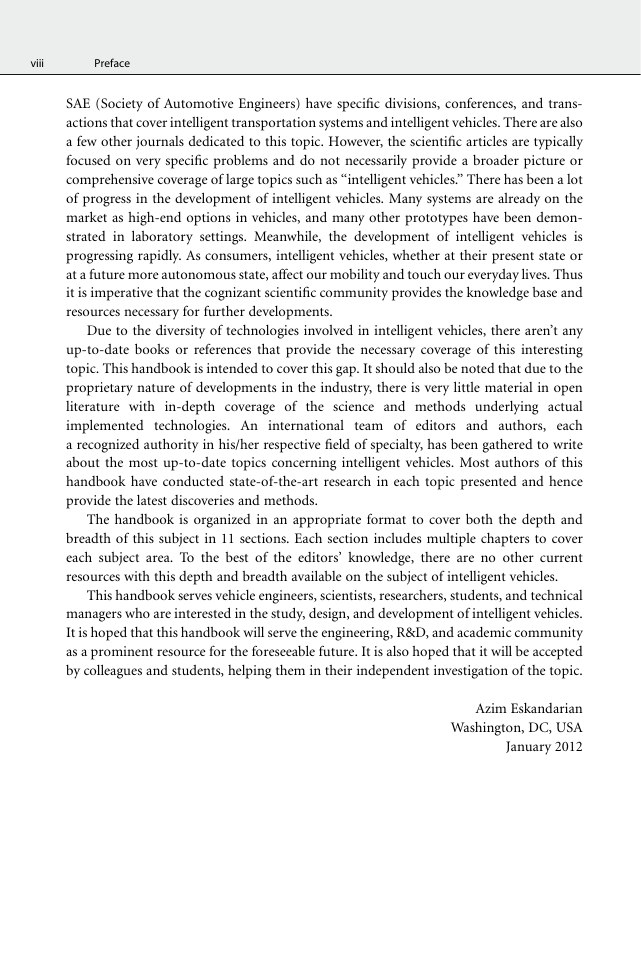01_FM.pdf
01_Halftitle.PDF
02_title_page.PDF
03_Copyright.PDF
04_Dedication.PDF
05_Preface.PDF
06_Acknowledgement.PDF
07_Editor_Bio.PDF
08_List_of_Section_Editors.PDF
09_TOC.PDF
10_List_of_Contributors.PDF
02_Binder1.pdf
01.pdf
1 Introduction to Intelligent Vehicles
1 Background
2 Traffic Safety
3 Energy and Environment
4 Governmental Efforts: Intelligent Transportation Systems
5 Some Basic Definitions of Intelligent Vehicles
6 Purpose and Scope of This Handbook
6.1 Purpose
6.2 Coverage of Topics
References
02.pdf
2 A Strategic Approach to Intelligent Functions in Vehicles
1 Introduction
2 Classification
3 Route Guidance Systems
4 Advanced Driver Assistance
5 Automatic Vehicles
6 Non-technological Issues
7 Conclusions
References
03.pdf
3 Sensing and Actuation in Intelligent Vehicles
1 Introduction
2 Sensing
2.1 General In-Vehicle Sensors
2.1.1 Yaw Rate Sensor
2.1.2 Accelerometer
2.1.3 Wheel Speed Sensor
2.1.4 Steering Angle Sensor
2.1.5 Other Sensors
2.2 Perception Sensors
2.2.1 Radar Sensors
Short-Range Radar (SRR)
Long-Range Radar (LRR)
2.2.2 Laser Scanners
2.2.3 Vision Systems
CCD and CMOS Vision Systems
IR Vision Systems
Stereovision Systems
Typical Performance of Vision Systems
2.2.4 Ultrasonic Sensors
2.3 Virtual Sensors
2.3.1 Digital Map
2.3.2 Wireless Communication
3 Actuation
3.1 Categories of Actuators According to Energy Source
3.1.1 Mechanical Actuators
3.1.2 Electrical Actuators
3.1.3 Pneumatic and Hydraulic Actuators
3.1.4 Piezoelectric Actuators
3.1.5 Thermal Bimorphs
3.2 ABS, ESC and ACC Systems
3.3 Assisted Steering and Steer-by-Wire Systems
3.4 Brake-by-Wire Systems
3.5 Highly Automated Vehicles
3.5.1 Autonomous Vehicles Demonstrated in the Past
3.5.2 Advanced Automated Systems Under Development
4 Conclusion
References
04.pdf
4 Situational Awareness in Intelligent Vehicles
1 Introduction
2 The Big Picture: Situational Awareness for Intelligent Vehicles
3 Situational Awareness and Communication
4 World Modeling, Representation
5 Situational Awareness in Control
6 Conclusions
References
05.pdf
5 Hierarchical, Intelligent and Automatic Controls
1 Introduction
2 Control Design Methods
2.1 Static Feedback Control
2.2 Optimal Control and Model Predictive Control
2.2.1 Optimal Control
2.2.2 Model Predictive Control
2.3 Artificial Intelligence Techniques
3 Hierarchical Control Framework
3.1 PATH Framework
3.2 A Modified Version of the PATH Framework
3.3 Dolphin Framework
3.4 Auto21 CDS Framework
3.5 CVIS
3.6 SafeSpot
3.7 PReVENT
3.8 Comparison of IVHS Frameworks
4 Control of Vehicle Platoons
4.1 Problem Formulation
4.1.1 Vehicle Following
4.1.2 Control System Components
4.2 String Stability Literature Review
4.2.1 Platooning Requirements
4.2.2 The Lyapunov-like Approach
4.2.3 The Performance-Oriented Approach
4.2.4 The z-Domain Approach
4.2.5 Concluding Remarks on String Stability
4.3 Case Study
5 Roadside and Area Control
5.1 MPC for Roadside Controllers
5.2 MPC for Area Controllers
5.3 Interfaces Between the Different Control Layers
6 Challenges and Open Issues
7 Conclusions
References
06.pdf
6 Behavioral Adaptation and Acceptance
1 Introduction
1.1 Direct Behavioral Adaptation
1.2 Indirect Behavioral Adaptation
2 Models of Behavioral Adaptation
3 Types of Behavioral Adaptation
4 When Does BA Occur?
5 Behavioral Adaptation in a Longer-Term Perspective
6 Relation Behavioral Adaptation and Safety
7 Behavioral Adaptation and Acceptance
8 Future Directions
9 Will New Skills Appear?
10 International Aspects of Adaptation to ADAS
11 General Conclusions
References
07.pdf
7 Simulation Approaches to Intelligent Vehicles
1 Introduction
2 Simulation Environment
2.1 The Role of Simulation and Modeling in the Development Process
2.2 Requirements for Simulation and Modeling
2.3 Simulation Environment
3 Traffic Flow Simulation Models
3.1 The Basics of Traffic Flow Simulation
4 Concept Development
4.1 Introduction
4.2 Cooperative Adaptive Cruise Control
4.3 Simulation Setup
4.4 Results
4.5 Discussion
5 Application Testing and Verification
5.1 Introduction
5.2 Requirements on Simulation in a Laboratory Test Environment
5.3 An Example: The SAFESPOT Test Bench
5.3.1 Setup 1: Application Unit Testing
5.3.2 Setup 2: Testing the Integration of Applications with Facilities
5.3.3 Setup 3: Application Platform Testing
5.3.4 Setup 4: Testing the Cooperation with External Vehicles and Roadside Units
6 Application Validation and Evaluation
6.1 An Example: Shockwave Damping
7 Conclusions and Challenges
References
08.pdf
8 Vehicle Longitudinal Control
1 Introduction
1.1 History of Vehicle Longitudinal Control
1.2 Functionality of Vehicle Longitudinal Control
2 System Requirements and Framework Design
2.1 System Requirements
2.2 System Framework
3 Vehicle Longitudinal Control
3.1 Sensors for Longitudinal Control
3.2 Longitudinal Vehicle Model
3.3 Longitudinal Control System Design
3.3.1 Upper Level Controller
3.3.2 Lower Level Controller
3.4 Experimental Results
4 Integrated Lateral/Longitudinal Control
5 Longitudinal Control of Automated Buses
5.1 Bus Precision-Stopping Control
6 Conclusion
References
09.pdf
9 Adaptive and Cooperative Cruise Control
1 Introduction
2 System Architecture and Operation Modes
2.1 Overview and Operation Modes
2.2 System Architecture and Components
2.2.1 ACC/CACC Controller
2.2.2 Range Sensor
2.2.3 Vehicle States Sensing
2.2.4 Human-Machine Interface
2.2.5 Wireless Communication
3 ACC/CACC Controller Design
3.1 Control Problem Formulation and Design Objectives
3.1.1 Control Problem Formulation
3.1.2 Control System Structure
3.1.3 Spacing Policy
3.1.4 String Stability
3.1.5 Other Objectives
3.2 Control Design Methodologies
3.2.1 Linear Controller Design
3.2.2 Nonlinear Controller Design
3.2.3 Model Predictive Control
3.2.4 Fuzzy Logic Control
4 Conclusion
References
10.pdf
10 Vehicle Lateral and Steering Control
1 Introduction
2 Major Vehicle Components in Lateral Motion
2.1 Tires
2.2 Linear Tire Model for Uniform Normal Force Distribution
2.3 Steering Wheel
2.4 Suspension System
3 Vehicle Model
3.1 Tire Models
3.1.1 Magic Formula Tire Model
3.1.2 Brush Model
3.1.3 Swift Tire Model
3.1.4 Linear Tire Model
3.2 Error Coordinates
3.3 Global Position of the Vehicle
3.4 Using Yaw Rate and Slip Angle as State Space Variables
4 Controllers
5 Desired Trajectory for Lane-Change and Lane Keeping Maneuvers
6 Some Experimental Studies
7 Case Studies
8 Electronic Stability Control (ESC)
9 Conclusions
References
11.pdf
11 Drive-By-Wire
1 Introduction
1.1 Vehicle-Driver Control Loop
1.2 Input Module Characteristics
2 Longitudinal Dynamic Systems
2.1 Functional Targets
2.1.1 Drive Functions
2.1.2 Brake Functions
2.1.3 Combined Function
2.2 Brake Pedal
2.2.1 Brake Pedal Characteristics
Pedal Force Versus Pedal Travel
Damping and Hysteresis
Amplification Factor of the Brake Booster
Jump In
Statute Law
2.2.2 Decoupled Brake Pedal
Regenerative Braking
Cruise Control with Braking
Antilock Braking/Dynamic Stability Control
Different HMI for Brake Commands
2.3 Integrated Longitudinal Control
2.3.1 Autonomous Driving
2.4 Longitudinal Dynamic By-Wire Control Systems
2.4.1 Electronic Accelerator Pedal
2.4.2 Accelerator Force Feedback Pedal (AFFP)
2.4.3 Brake Force Feedback Pedal
2.4.4 ABS/ESP System
2.4.5 Electrohydraulic Combi Brake (EHCB)
2.4.6 Electrohydraulic Brake EHB, Simulator Brake Actuation SBA
2.4.7 Full Electromechanical Brake System (EMB)
3 Lateral Dynamic
3.1 Functional Targets
3.2 Steer-By-Wire Feedback Design
3.3 Lateral Dynamic By-Wire Control Systems
3.3.1 Vertical Force
3.3.2 Longitudinal Force
3.3.3 Lateral Force
Power Steering Systems
Variable Steer Ratio
Superposition Steering
Rear Wheel Steering
Steer-By-Wire
4 Integrated Vehicle Dynamic
4.1 Corner Module
4.2 Control Strategy
5 Functional Safety and Availability
5.1 Basic Design of Safety Critical Systems
5.1.1 Safe State of a Vehicle with the System(s)
5.1.2 Danger and Risk Analysis
5.1.3 Degradation
5.1.4 Environment for Safe Drive-By-Wire
5.2 Example: Electronic Throttle
6 Conclusion
References
12.pdf
12 Energy and Powertrain Systems in Intelligent Automobiles
1 Introduction
2 Research Methodology
2.1 Real-World In-Car Measurements
2.2 Calculation Model
2.3 Representative Real-World Driving Routes
2.4 Power Requirement of the Vehicle
3 Energy Storage Systems
4 Vehicle and Powertrain Concepts
4.1 Motivation for New Propulsion Systems
4.2 Internal Combustion Engine Vehicle
4.3 Hybrid Electric Vehicle
4.4 Fuel Cell Electric Vehicle
4.5 Battery Electric Vehicle
5 Energy Consumption
5.1 Tank-To-Wheel Energy Consumption
5.2 Primary Energy Consumption
6 Summary
7 Symbols and Abbreviations
Acknowledgments
References
13.pdf
13 Global Navigation Satellite Systems: An Enabler for In-Vehicle Navigation
1 The GNSS Technology
1.1 GNSS for Vehicle Positioning
1.2 GNSS Technology Limitations
1.3 Current GNSSs
2 Principles
2.1 The Geometry of Satellite Positioning
2.2 Signal Properties
2.3 System Components and Structure
3 Theory
3.1 Pseudorange and Position Relation
3.1.1 Position Estimation
3.2 Received Signal and Pseudorange Relation
3.2.1 Undistorted Signal
3.2.2 Random Distortion
3.2.3 Systematic Distortion
4 Practice
4.1 Position Estimation
4.1.1 LS Position Estimation
4.1.2 MMSE Position Estimation
4.2 Measuring Pseudoranges
4.2.1 Signal Acquisition
4.2.2 Carrier and Code Phase Tracking
4.2.3 Carrier Phase Tracking
4.2.4 Navigation Data
4.3 Pseudorange Error Sources
4.4 GNSS Receivers
4.4.1 GNSS Antennas
4.4.2 RF Front End and ADC
4.4.3 Hardware Signal Acquisition Implementation
4.4.4 Hardware Pseudorange Tracking Loop Implementation
4.4.5 Position Estimation
4.4.6 Software Receivers
5 Differential GNSS
5.1 Principles
5.2 Augmentation Systems
5.2.1 Satellite-Based Augmentation Systems
5.2.2 Ground-Based Augmentation Systems
6 Conclusion and Further Reading
References
14.pdf
14 Enhancing Vehicle Positioning Data Through Map-Matching
1 Spatial Road Map
1.1 Errors in Map Creation
1.2 Errors in Digitization
1.3 Numerical Data Related to a Spatial Road Map
2 Digital Map Quality
3 Methods of Map-Matching
3.1 Geometric Analysis
3.2 Topological Analysis
3.3 Analysis with Advanced Techniques
4 Integrity and Reliability of Map-Matching
5 Intelligent Vehicles and Map-Marching Algorithms
6 Summary
References
15.pdf
15 Situational Awareness and Road Prediction for Trajectory Control Applications
1 Introduction
2 Modeling the Environment with a Map
3 Feature-Based Map
3.1 Radar and Laser
3.2 Cameras and Computer Vision
4 Road Map
4.1 Road Model
4.2 Mapping of the Road Lanes
4.3 Mapping of the Road Edges
5 Occupancy Grid Map
5.1 Background
5.2 OGM with Radar Measurements
5.3 Experiments and Results
6 Intensity-Based Map
7 Conclusion
Acknowledgments
Acknowledgments
References
16.pdf
16 Navigation and Tracking of Road-Bound Vehicles Using Map Support
1 Introduction
2 State Estimation and Representation
2.1 Nonlinear Filtering
2.1.1 Kalman Filter Variants
2.1.2 Point Mass and Particle Filter Variants
2.1.3 Finite State Space Models
2.2 Introductory Illustrations
3 Basic Motion Models
3.1 Dead-Reckoning Model
3.2 A Complete Matlab Algorithm
3.3 Tracking Model
3.4 Manifold Model
4 Map Handling
4.1 The Shape Format
4.2 Computational Issues Related to the Map
5 Navigation Applications
5.1 Odometric Approach
5.2 Odometric Approach with Parameter Adaptation
5.3 Inertial Measurement Support
6 Tracking Approaches
6.1 Radar Support
6.2 Wireless Radio Network Support
6.3 Sensor Network Support
6.4 Vision Support
7 Conclusions
Acknowledgments
Acknowledgments
References
17.pdf
17 State-of-the-Art In-Car Navigation: An Overview
1 Principles of In-Car Navigation Systems
1.1 Navigation System Building Blocks
1.2 Navigation System Figures of Merits
2 Global Navigation Satellite Systems
2.1 Global Navigation Satellite Systems
2.2 GNSS Error Sources
2.3 Horizontal Position Accuracy Prediction
2.4 Differential GNSS
2.5 GNSS Integrity Monitoring
2.5.1 Key Steps in Integrity Monitoring
3 Vehicle Motion Sensors
3.1 Non-Self-Contained Encoder-Based Motion Sensors
3.2 Self-Contained Motion Sensors
3.3 Errors Sources for Inertial Sensors
4 Coordinate Systems
4.1 Coordinate Systems
5 Information Processing Based on Vehicle Sensors
5.1 Dead-Reckoning
5.2 Inertial Navigation
5.3 Vehicle Models and Motions
6 Digital Maps and Map-Matching
6.1 Digital Maps
6.2 Map-Matching Steps
7 Information Fusion
7.1 Filter Structures
7.1.1 Filter Structures for Information Fusion
7.2 Filter Algorithms
7.3 Information Fusion in Systems Including a GNSS Receiver
8 Summary
References
18.pdf
18 Evolution of In-Car Navigation Systems
1 Introduction
2 Trace the History of In-Car Navigation System
3 Car Navigation System Architecture
3.1 Conversion of In-Car Navigation System Architecture
3.2 Portable Navigation Device Architecture
4 Trend and Future of In-Car Navigation System Functions
4.1 Navigation
4.2 Audio and Video
4.3 Communication
4.4 Voice Recognition and Speech Synthesis
4.5 Display
4.6 Camera Application
4.7 Green Technology Application
4.8 Electric Vehicle Navigation System
5 Conclusion
References
19.pdf
19 Fundamentals of Driver Assistance
1 Introduction
1.1 Background
1.2 Chapter Coverage
1.3 Driving Tasks
2 Driver Perception-Response
2.1 A General Human Response Model
2.2 Human Reaction Time
3 Driving Tasks and Other Influences on Perception-Response
3.1 Cognitive Perspective of Driving Tasks
3.2 Driver Distraction
4 Driver Assistance Types and Levels
4.1 Classification According to Level of Intervention
4.1.1 Informational
4.1.2 Warning
4.1.3 Partial (Semi) Control
4.1.4 Automatic Control
4.1.5 Autonomous Control
4.2 Classification According to Adaptability
4.3 Other (Temporal) Classification of ADAS
5 Integrated Safety
6 Human-Vehicle Interface
6.1 Feedback to Driver
6.1.1 Age Consideration
6.1.2 Mental Workload
6.1.3 Vigilance
6.2 Receive Driver´s Input
6.3 Actuations: Execute Automatic and Autonomous Action
7 Testing and Evaluation
8 Samples of Driver Assistance Systems (Case Studies) and Future Research Needs
8.1 Examples of Existing ADAS
8.1.1 Brake Assist System Supports Braking by Intervention
8.1.2 Adaptive Headlights Enhances Visibility and Safety at Night Driving
8.1.3 Blind Spot Detection Augments Driver´s Field of View and Provides Visual Feedback
8.1.4 Lane Departure Warning Improves Situational Awareness, Warns/Alerts driver/Lane Departure Control Improves Situational Awaren
8.1.5 Driver Assistance Pack
8.2 Future Research
9 Concluding Remarks
References
20.pdf
20 Driver Behavior Modeling
1 Introduction
2 Driver Behavior Modeling Framework
3 Operational Stage Acceleration Models
3.1 Fundamental Diagram
3.2 Trajectories
4 Tactical Stage Lane Changing Models
5 Conclusion
References
21.pdf
21 Using Naturalistic Driving Research to Design, Test and Evaluate Driver Assistance Systems
1 What Is Naturalistic Driving Research?
2 Naturalistic Driving Research: Bridging Epidemiology and Empirical Research
3 NDS Methods
3.1 Data Acquisition System (DAS)
3.2 Vehicle Instrumentation
3.3 Vehicle Data Collection
3.4 Participant Data Collection
3.5 NDS Data Reduction
3.6 NDS Data Analysis
4 Using NDSs in Designing Driver Assistance Systems
4.1 Using NDSs to Identify User Requirements
4.2 Using NDSs to Guide the Design of Driver Assistance Systems
4.3 Using NDSs to Test Driver Assistance Systems
4.3.1 Testing Early-Stage Prototypes
4.3.2 Testing Working Prototypes
4.4 Using NDSs to Evaluate Driver Assistance Systems
5 Conclusion
6 Case Study
References
22.pdf
22 Intelligent Speed Adaptation (ISA)
1 Introduction
2 A Taxonomy of Intelligent Speed Adaptation Systems
2.1 Speed Limit Calculation
2.2 System Output
3 Benefits of Intelligent Speed Adaptation Systems
3.1 Relationship Between Speed and Safety
4 Speed Reduction and Benefits of ISA
5 Challenges Facing Intelligent Speed Adaptation Systems
5.1 Acceptability and Effectiveness
5.2 Negative Safety Effects
6 Research Case Study in the United States: Advanced Vehicle Speed Adaptation System
6.1 Development of AVSAS
6.2 Results of Data Analysis and Consumer Acceptance
6.3 Conclusions
7 Other Case Studies
7.1 STARDUST Project
7.2 Swedish Test (Eslöv)
7.3 Managing Speeds of Traffic on European Roads (MASTER)
7.4 The Australian TAC SafeCar Project
7.5 INFATI Danish ISA
7.6 Swedish ISA Tests
7.7 The Netherlands ISA Experiment
7.8 ARENA Programme (Gothenburg, Sweden)
7.9 Flemish ISA
8 Conclusion
Acknowledgments
Acknowledgments
References
23.pdf
23 Safety and Comfort Systems: Introduction and Overview
1 Safety and Comfort
2 The Driver-Vehicle-Environment Control Loop
3 Human-Machine Interaction
4 Development Principles
References
24.pdf
24 Adaptive Cruise Control
1 Introduction
2 Requirements
2.1 Functional Requirements for Standard-ACC Pursuant to ISO 15622
2.2 Additional Functional Requirements for FSR-ACC Pursuant to ISO 22179
3 System Structure
4 ACC State Management and Human-Machine Interface
4.1 System States and State Transitions
4.2 Control Elements
4.3 Display Elements
5 Target Object Detection for ACC
5.1 Requirements of the Environmental Sensors
5.2 Measurement Ranges and Accuracies
5.2.1 Distance
5.2.2 Relative Speed
5.2.3 Lateral Detection Area for Standard ACC Function
5.2.4 Lateral Detection Range for FSRA
5.2.5 Vertical Detection Range
5.2.6 Multi-target Capability
6 Target Selection
6.1 Determination of the Path Curvature
6.2 Path Prediction
6.3 Driving Corridor
6.4 Further Criteria for Target Selection
6.5 Target Selection Limits
7 Vehicle-Following Control
7.1 Basic Observations with Respect to Vehicle-Following Control
8 Target-Loss Strategies and Curve Control
8.1 Approach Strategies
8.2 Reaction to Static Objects
9 Longitudinal Control and Actuators
9.1 Basic Structure and Coordination of Actuators
9.2 Brake
9.2.1 Actuator Dynamics
9.2.2 Control Comfort
9.2.3 Feedback Information
9.3 Drive
9.3.1 Engine Control (Control Range, Actuator Dynamics, Steps/Accuracy, Feedback Information [Loss Torque of Ancillary Units])
Special Features of Combination with Manual Transmissions
9.3.2 Transmission Control
10 Use and Safety Philosophy
10.1 Transparency of the Function
10.2 System Limits
11 Safety Concept
12 Users and Acceptance Studies
12.1 Acceptance
12.2 Use
12.3 Driver-Control-Take-Over Situations
12.4 Comfort Assessment
13 Conclusion and Outlook
13.1 Current Developments
13.2 Function Enhancements
Acknowledgments
Acknowledgments
References
25.pdf
25 Forward Collision Warning and Avoidance
1 Introduction
1.1 Motivation and Early Research Approaches
1.2 Definitions and Abbreviations
2 Machine Perception for FCW and FCA
3 Approaching a Definition of FCX-Systems
4 Design Parameters of Actual Realizations
4.1 CU-Criterion
4.2 Fundamentals of Driver Warning
4.3 Levels of Assistance in Dangerous Situations
4.3.1 FCC-Systems
4.3.2 FCW-Systems
4.3.3 Rear Impact Countermeasures
4.3.4 FCM-Systems
4.3.5 FCA-Systems
5 Levels of Assistance in an Actual Realization
5.1 Survey of Different Realizations by the Car Manufacturers
6 System Architecture
6.1 Functional System Architecture
7 Design Process
7.1 Systematic Design of Driver Assistance Systems
7.2 Example: Systematic Design of an ``Automatic Emergency Brake´´
7.2.1 User-Oriented Definition of the Function
7.2.2 Functional Tests of Driver Assistance Systems
7.2.3 Test Case ``Justified Intervention´´: Vehicle-in-the-Loop
7.2.4 Error Probability for ``Unjustified Interventions´´: Trojan Horses
8 Conclusion
References
26.pdf
26 Lane Departure and Lane Keeping
1 Introduction
2 Function Description
2.1 Lane Departure Warning Function
2.2 Lane Keeping Assist Systems
2.3 Combined and Integrated Lateral Support Systems
3 Development of LDW and LKA Systems
3.1 Lane Marker Recognition
3.2 Warning Elements
3.3 Lane Keeping Assistance Controller and Actuator (Just LKAS)
4 Market Trend and Outlook
5 Conclusion
References
27.pdf
27 Integral Safety
1 Introduction
2 Limitations of Passive Safety Systems
3 The Approach of Integral Safety
4 Quantification of Field Effectiveness
5 Summary and Conclusion
References
28.pdf
28 Lane Change Assistance
1 Introduction
2 Requirements
3 Classification of System Functions
3.1 Coverage Zone Classification
3.2 State Diagram
4 Test Procedures
4.1 General Boundary Conditions
4.2 Target Vehicle Overtaking Subject Vehicle
4.3 Subject Vehicle Overtaking Target Vehicle
4.4 False Warning Test
4.5 Target Vehicle Moving Laterally
5 Sample Implementations
5.1 ``Audi Side Assist´´
5.2 ``Lane Change Warning´´ from BMW
5.3 ``Blind Spot Information System´´ from Ford
5.4 ``Side Blind Zone Alert´´ from GM
5.5 ``Blind Spot Monitor´´ from Jaguar
5.6 ``Rear Vehicle Monitoring System´´ from Mazda
5.7 ``Blind Spot Assist´´ from Mercedes-Benz
5.8 ``Side Collision Prevention´´ from Nissan/Infiniti
5.9 ``Blind Spot Detector´´ from Peugeot
5.10 ``Blind Spot Information System´´ (BLIS) from Volvo
5.11 ``Side Assist´´ from VW
5.12 Summary
6 Achieved Performance Capability
7 Further Developments
Acknowledgments
Acknowledgments
References
29.pdf
29 Steering and Evasion Assist
1 Introduction
2 Potential of Evasion Versus Braking
3 System Layout
3.1 Overview
3.2 Requirements for Situation Analysis
3.3 Requirements for Environment Perception
3.4 Actuators
3.4.1 Steer Torque Actuator
3.4.2 Steer Angle Actuator
3.4.3 Rear Wheel Steering
3.4.4 Warping the Suspension
3.4.5 Single-Sided Braking
3.4.6 Torque Vectoring
3.4.7 Discussion
3.5 HMI and Customer Acceptance
4 Case Studies
4.1 Survey of Research Activities of Industry and Academia
4.2 The Daimler Automatic Evasion Assistance for Pedestrian Protection
4.2.1 Motivation
4.2.2 System Description
Sensor Processing
Fusion
Trajectory Generation, Situation Analysis, Decision and Intervention, and Vehicle Control
4.2.3 Experiments
5 Conclusion
References
30.pdf
30 Proactive Pedestrian Protection
1 Introduction
2 Overview of Pedestrian Accidents
2.1 International Comparison of Pedestrian Accidents
2.2 Analysis of the German In-Depth Accident Study
2.2.1 The GiDAS Project: In-Depth Accident Investigation
2.2.2 Results of Analyzing Pedestrian Accidents
3 Infrastructural and Passive Pedestrian Safety
3.1 Infrastructural Pedestrian Safety
3.2 Passive Pedestrian Safety
3.3 Current Test Procedures for Passive Pedestrian Safety
4 Active Pedestrian Safety Systems
4.1 Approach of Integrated Vehicle Safety
4.2 Overview of Environment Sensor Systems
4.3 Functional Algorithm for Collision Prediction
4.4 Actuating Elements for Active Pedestrian Safety Systems
4.4.1 Brake Assist System
4.4.2 Autonomous Braking System
4.4.3 Elements for Driver Warnings
5 Development of Active Pedestrian Safety Systems
5.1 Integrated Development Process of Active Pedestrian Safety Systems
5.2 Definition of Active Pedestrian Protection Systems
5.2.1 Simulation of Pedestrian Accident Scenarios
5.2.2 Informative and Warning System Strategies
5.2.3 Autonomous System Strategies
5.3 Testing of Active Pedestrian Safety Systems
5.3.1 System Test on a Pedestrian Protection Test Facility
5.3.2 System Test with the Vehicle-in-the-Loop
5.4 Real-World Benefit Calculation of Active Pedestrian Safety Systems
5.4.1 Procedures for Calculating the Real-World Benefit
5.4.2 Generation of Injury Risk Curves for Pedestrian Collisions
6 Conclusion
References
31.pdf
31 Parking Assist
1 Introduction
2 Ultrasonic Technology for Automotive Sensors
2.1 Fundamentals of Ultrasonic Technology
2.2 Piezoelectric Effect and Piezoelectric Materials
2.3 Emission of the Ferroelectric Transducer
2.4 Detection Area of Ultrasonic Transducers
2.5 Distance Measurement
2.6 Ultrasonic Sensor
2.7 Sensor Integration into the Bumper
3 Video Technology for Automotive Application
3.1 Fundamentals of Photosensing
3.2 CCD Sensors
3.3 CMOS Sensors and Imagers
3.4 Structure of Video Cameras and of a Vision System
4 Parking and Maneuvering Assistance Systems
4.1 Requirements to Parking Assistance Systems
4.2 Categories of Parking and Maneuvering Assistance Systems
4.2.1 Passive Systems
Warning Parking Assistance
Ultrasonic Parking Aid
Electronic Control Unit
Warning Elements
Informing Parking Assistance
Parking-Space Measurement
Park Steering Information
Rear-View Camera (Picture Only)
Rear-View Camera with Auxiliary Lines
Around-View System
4.2.2 Active Systems
Semiautomatic Parking Assistance
System for Steering into Parking Spaces
New Assistant for Driving out of Parking Spaces
Fully Automatic Parking Assistance
Autonomous Parking Systems
5 Benefit of Parking Systems
6 Functional Limits of Parking Assistance Systems
7 Legal Aspects of Parking Assistance Systems
8 Conclusion
References
32.pdf
32 Post-crash Support Systems
1 Introduction
2 Opportunities for Improved Post-crash Care
3 Estimating Crash Injury Risk Following a Crash
4 Injury Risk Threshold Selection
5 Future Opportunities to Improve Post-crash Care
6 Conclusion
References
33.pdf
33 Map Data for ADAS
1 Introduction: The Use of Maps Today Within the Automotive Industry
2 Energy-Management Applications Using Maps
2.1 Fuel-Efficient Routing (Also Referred to as ``Eco-routing´´)
2.2 Electric Vehicle Range Prediction
2.3 Eco-driving/Predictive Gear-Shifting/Predictive Cruise Control
3 Safety Applications Using Maps
3.1 Predictive Front Lighting
3.2 Overtaking Assistant
3.3 Curve Speed Warning
4 Requirements on Maps from These New Applications
5 Future Directions for Maps in Vehicles
6 Conclusions
References
34.pdf
34 Advances in Drowsy Driver Assistance Systems Through Data Fusion
1 Introduction
2 Defining the Problem: Fatigue Versus Drowsiness
3 Salient Measures of Driver Drowsiness
3.1 Driver-Based Approaches
3.1.1 Electroencephalography (EEG) Measure
3.1.2 Ocular Measures
3.2 Vehicle-Based Approaches
3.2.1 Lane Position/Line Crossing
3.2.2 Steering Wheel Inputs
3.3 Measures of Driver Drowsiness Summary
4 Development of a Robust Drowsy Driver Assistance System
4.1 Case Study of Prototype DDAS Utilizing a Data Fusion Approach
4.1.1 Drowsiness Indicator Selection
4.1.2 Fusion of Data from Two Drowsiness Indicators
4.1.3 Testing and Evaluation of Prototype DDAS
5 Conclusion
References
35.pdf
35 Drowsy Driver Posture, Facial, and Eye Monitoring Methods
1 Introduction
2 Background
2.1 Facial Activity Recognition
2.1.1 Facial Feature Point Tracking
2.1.2 Facial Expression Recognition
2.2 Eye Gaze Estimation
3 Facial Feature Point Tracking
3.1 Facial Feature Point Representation
3.2 Pose-Dependent Active Shape Model
3.2.1 Active Shape Model
3.2.2 Robust Face Pose Estimation
3.2.3 Face Shape Compensation
4 A Unified Framework for Simultaneous Facial Activity Tracking
4.1 DBN Model Parameterization
4.1.1 Expression Level
4.1.2 AU Level
4.1.3 Facial Feature Level
4.2 DBN Inference: Simultaneous Facial Feature Tracking and Expression Recognition
4.3 Result on the Cohn-Kanade Database
5 3D Gaze Estimation Based on Facial Feature Points Without IR Illumination
5.1 Step 1. Facial Feature Point Tracking and Face Pose Estimation
5.2 Step 2. Estimate the 3D Model Point M
5.3 Step 3. Compute 3D Position of C
5.4 Step 4. Compute P
5.5 Step 5. Compute Gaze
5.6 Gaze Estimation Result
6 Conclusion
References
36.pdf
36 Drowsy and Fatigued Driving Problem Significance and Detection Based on Driver Control Functions
1 Introduction and Problem Statement
2 Characteristics of Drowsiness and Fatigue
3 Characteristics of Drowsiness and Fatigue-Related Accidents
4 Drowsiness and Fatigue Detection Systems
5 Sensing Driver´s Physical and Physiological Conditions
6 Sensing Vehicle State Variables
7 Correlation between Drowsiness and Vehicle State Variables
7.1 Vehicle Steering Activity
7.1.1 Frequency of Steering Wheel
7.1.2 Steering Wheel Reversal Rate
7.1.3 Steering Correction
7.1.4 Steering Velocity
7.1.5 Steering Amplitude Duration Squared Theta
7.1.6 Weight Flat Zero
7.2 Lateral Position
7.3 Vehicle Speed
7.4 Yaw/Brake/Acceleration
8 Drowsiness Detection Methods Based on Vehicle State Variables
9 Examples of Drowsiness Detection Methods
10 Advantages and Disadvantages of Detection Systems Using Vehicle State Variables
11 Design and Implementation Challenges to Consider
12 Conclusion
References
37.pdf
37 Drowsy and Fatigued Driver Warning, Counter Measures, and Assistance
1 Introduction
2 Alarm Modality
2.1 Visual Display
2.1.1 Warning Symbols
2.2 Auditory (Sound)
2.2.1 Warning Compliance (Urgency)
2.2.2 Tones and Voice Messages
2.2.3 Limitations of Auditory Warnings
2.3 Haptic/Tactile
3 Alarm Timing
4 System Reliability and Sensitivity
4.1 False Alarms
4.2 Setting Decision Thresholds for Warning Systems
4.3 Alarm Based on Likelihood of Falling Asleep
4.4 Graded (Staged) Alarm
5 Designing a Warning System
6 User Acceptance and Trust
7 Counter Measures Against Driver Fatigue/Drowsiness
7.1 Legislation/Enforcement
7.2 Driver Education
7.3 Rumble Strips
7.4 Other Strategies
8 Commercially Available Systems
9 Conclusion
References
38.pdf
38 Image Processing for Vehicular Applications
1 Setup
1.1 Functionality
1.2 Technical Feasibility of Device Positioning
1.3 Wiring and Positioning
1.4 Lighting Control
2 Specific Machine Vision Issues in the Automotive Field
2.1 Vehicle Ego-Motion
2.2 Oscillations and Vibrations
2.3 Illumination Conditions
3 Conclusions
References
39.pdf
39 Camera Technologies
1 Camera Definition
1.1 Camera Classification
1.2 Sensor
1.2.1 Dynamic Range
1.3 Speed
1.4 Image Format
1.5 Exposure Parameters
1.6 Optics
1.7 Sensors
1.8 Software
1.9 Mechanical Issues
1.10 Conclusions
References
40.pdf
40 Perception Tasks: Lane Detection
1 Introduction
2 Lane Detection Requirements
3 A Lane Detection Algorithm
3.1 Low-Level Processing
3.2 Lane Marking Extraction
3.3 Tracking and Generation
3.4 Expansion and Validation
4 Results
5 Conclusions
References
41.pdf
41 Perception Tasks: Obstacle Detection
1 Introduction
2 Sensors for Obstacle Detection
2.1 Proprioceptive and Exteroceptive Sensors
2.2 Active and Passive Sensors
3 Obstacle Detection Methods
3.1 Active Sensor Use
3.2 Vision
3.3 Multi-sensor Fusion
4 Conclusion
References
42.pdf
42 Perception Tasks: Traffic Sign Recognition
1 The System
2 Color Analysis
2.1 Color Segmentation
2.2 Chromatic Equalization
3 Shape Detection
3.1 Bounding Boxes Merge and Split
3.2 Pattern Matching
4 Shape Detection Based on Sobel Phase Analysis
4.1 Edges Detection
4.2 Analysis of the Sobel Phase Distribution
5 Classification
5.1 Neural Network
5.2 Tracking
6 Output and Results
7 Conclusions
References
43.pdf
43 Vision-Based ACC
1 Introduction
2 Systems
3 Algorithm Overview
3.1 Vehicle Detection
4 Conclusions
References
44.pdf
44 Vision-Based Blind Spot Monitoring
1 Image Acquisition
2 Vehicle Detection
2.1 Pattern Analysis
2.2 Optical Flow Estimation
2.3 Features Extraction
2.4 Features Tracking
3 Algorithm Overview
4 Conclusions
References
45.pdf
45 Vehicular Communications Requirements and Challenges
1 Vehicle Communications Overview
2 System Concepts
3 Geographic Context
4 Temporal Context
5 Reliability Context
5.1 RF Signal Level
5.2 Multipath Effects
5.3 Hidden Terminal Effects
5.4 Density and Bandwidth/Congestion Effects
6 DSRC Overview
6.1 Communicating Entities
6.2 Channels
7 Mobile Terminals
7.1 Embedded Vehicle Terminal
7.2 Aftermarket Vehicle Terminal
7.3 Portable Consumer Electronic Terminal
7.4 Infrastructure Terminals
8 Example Implementations
8.1 Signage
8.2 High Priority Signage
8.3 Lower Priority Signage
8.4 Probe Data Collection
8.5 Traffic Signal Violation Warning
9 Conclusion
References
46.pdf
46 Vehicle-to-Vehicle (V2V) and Vehicle-to-Infrastructure (V2I) Communications and Cooperative Driving
1 Communications Supported Intelligent Vehicle Systems
2 Vehicle-To-Infrastructure (V2I) Systems
2.1 V2I Applications
2.1.1 Static Events
2.1.2 Dynamic Events
2.1.3 Data Exchange Applications
2.2 V2I Application Physical Setup
3 Vehicle-To-Vehicle (V2V) Systems
3.1 Cooperative Driving Overview
3.1.1 Basic Safety Message
3.2 Longitudinal Trajectory Applications
3.2.1 Cooperative Cruise Control
3.2.2 Cooperative Forward Collision Warning/Avoidance
3.2.3 Emergency Electronic Brake Light
3.2.4 Do-Not-Pass Warning
3.3 Lateral Trajectory Applications
3.3.1 Blind Spot/Lane Change Warning
3.3.2 Highway Merge Assistant
3.4 Crossing Path Applications
3.4.1 Intersection Collision Warning/Avoidance (Through Path)
3.4.2 Intersection Collision Warning/Avoidance (Turning Path)
3.4.3 Intersection Movement Assist
3.5 Specialized Situational Applications
3.5.1 Emergency Vehicle Warning
3.5.2 Slow/Stopped Vehicle Ahead/Work Zone Warning from Maintenance Vehicles/Post-Crash Warning
3.5.3 Pre-crash Sensing
3.5.4 Control Loss Warning
3.6 Cooperative Communications
3.6.1 Vehicle-Based Road Condition Warning
3.6.2 Wrong Way Driver Warning
3.6.3 Mayday
4 Communications Requirements
4.1 Range
4.2 Link Budget
4.3 Transmit Power and Sensitivity
4.4 Additional Reliability Elements
4.5 Localization Versus Bandwidth and Capacity
4.6 Networking
5 Conclusions
References
47.pdf
47 Probes and Intelligent Vehicles
1 Introduction
1.1 What Are Probes?
1.2 Technology
1.2.1 Vehicle Installation
1.2.2 Communications
2 Applications
2.1 Real-Time Applications
2.1.1 Traffic Reporting
2.1.2 Traffic Smoothing
2.1.3 Active Signal Management
2.1.4 Weather
2.2 Historic Data
2.2.1 Transportation Network Design and Maintenance
2.2.2 Traffic Control Attribute Detection
2.3 Probe Maps
2.3.1 Road Classification
2.3.2 IntersectionGeometry
2.3.3 Instantaneous Speed Data
2.3.4 Application Development and Validation
2.4 Privacy
2.4.1 Increasing Probe Penetration
3 Conclusion
References
48.pdf
48 Threat Model, Authentication, and Key Management
1 Introduction
1.1 Vehicle Network Reference Architecture
2 Threat Model
2.1 Threat Agents
2.2 Threat Motives
2.3 Threats
2.3.1 Compromise of Vehicle OBE
2.3.2 RF Jamming
2.3.3 RF Eavesdropping and Message Insertion
2.3.4 Vehicle Tracking and Privacy Violations
A Notion of Privacy
Vehicle Tracking
Tracking Using Application-Specific Identifiers
Speed Trap Example
2.3.5 Access Point/Roadside Equipment Impersonation
2.3.6 Viruses and Self-Replicating Worms
2.3.7 Other Threats
3 Message Authentication
4 Certificate Management
4.1 Combinatorial Certificate Management
4.1.1 Privacy
4.1.2 Effect of Certificate Revocation
4.2 Short-Lived, Unlinked Certificates
4.2.1 Privacy
4.2.2 Authorizing Certificate Authority Functions
4.2.3 Assigning Certificate Authority Functions
4.2.4 Certificate Request Transaction Flow
4.2.5 Detection and Removal of a Misbehaving Vehicle
4.2.6 Weaknesses
5 IntelliDrive Security Architecture
6 Intrusion Detection in Vehicle Networks
6.1 Intrusion Detection by OBEs
6.2 Intrusion Detection by RSEs
6.3 Network-Based Intrusion Detection
6.4 Intrusion Detection by Certificate Authority
6.5 Intrusion Detection by Application Server
7 Conclusion
References
49.pdf
49 Security, Privacy, Identifications
1 Overview
2 Overview of Communications Security Services
2.1 Standard Cryptographic Security Services: Confidentiality, Authenticity, Integrity, Non-repudiation
2.2 Anti-Replay and Relevance
2.3 Availability
2.4 Authorization
2.4.1 Privilege
2.5 Privacy
2.5.1 Regulatory Aspects of Privacy
2.5.2 Mechanisms
3 Standards, Field Operational Tests, Research Projects
3.1 Standards
3.1.1 USA
IEEE
SAE
3.1.2 EU
ETSI
3.1.3 ISO
3.2 Research Projects
3.2.1 US
3.2.2 EU
4 Security Services and Mechanisms for Applications and Their Support in Standards
4.1 Cooperative Awareness
4.1.1 Mechanisms for End-User Privacy in Cooperative Awareness Systems
4.1.2 Support in Standards
4.2 Static Local Hazard Warning
4.2.1 Support in Standards
4.3 Interactive Local Hazard Warning
4.3.1 Support in Standards
4.4 Area Hazard Warning
4.4.1 Support in Standards
4.5 Advertised Services
4.5.1 Support in Standards
4.6 Local High-Speed Unicast Service
4.6.1 Support in Standards
4.7 Local Groupcast Service
4.7.1 Support in Standards
4.8 Low-Speed Unicast Service
4.8.1 Support in Standards
4.9 Distributed (Networked) Service
4.9.1 Support in Standards
4.10 Multiple Applications
5 Security Management Services
5.1 Initialization
5.1.1 Public Key
5.1.2 Symmetric Key
5.2 Key Update, Revocation, and Removal of Misbehaving Devices
5.3 Implementation and Support in Standards
5.3.1 Device-Side Case Study: VIIC Proof of Concept
5.4 Multiple CAs and Roaming
5.5 Infrastructure-Side Case Study: National ITS Architecture (USA)
5.6 Privacy Against the CA
6 Multi-application, Physical, Platform, and IVN Security
6.1 Vehicular Platforms
6.2 Non-vehicular, Mobile, Multi-application Platforms
6.3 Security for the Long Term
7 Conclusion
References
50.pdf
50 Autonomous Driving: Context and State-of-the-Art
1 Introduction
2 Societal, Technological and Economical Motivators
3 Vehicle Intelligence and the Navigation Functions
3.1 Interaction
4 Classification of Technological Advances in Vehicle Technology
4.1 Driver Centric
4.2 Network Centric
4.3 Vehicle Centric
4.4 Evolution of Vehicle Architectures
5 Driver Centric Technologies
6 Network Centric Technologies
7 Vehicle Centric Technologies
8 State-of-the-Art in Fully Autonomous Driving Research
8.1 Early US Unmanned Vehicle Projects
8.2 Early EU Projects on Intelligent Vehicles
8.3 US DARPA Challenges on Autonomous Driving
8.4 EU Cybercars Projects
8.5 Lessons Learned from DARPA Challenges
9 Discussion, Conclusions and Structure of the Chapters
References
51.pdf
51 Modeling and Learning Behaviors
1 Introduction and Problem Statement
1.1 Motion Prediction and State Estimation
2 A Powerful Tool: The Bayes Filter
3 Model Learning
3.1 Intentional Models
3.2 Metric Models
4 Motion Learning and Prediction with Growing Hidden Markov Models
4.1 Hidden Markov Model-Based Approaches
4.2 Growing Hidden Markov Models
4.2.1 Probabilistic Model
4.2.2 Updating the Topological Map
4.2.3 Updating the Model´s Structure
4.2.4 Updating the Parameters
4.3 Practical Considerations
5 Case Study and Experimental Results
5.1 Compared Approaches
5.2 Performance Metrics
5.2.1 Measuring Model Size
5.2.2 Measuring Prediction Accuracy
5.3 Experimental Data
5.4 Results
5.4.1 Comparing Prediction Accuracy
5.4.2 Comparing Model Size
5.5 Analysis
6 Conclusions
References
52.pdf
52 Vision and IMU Data Fusion: Closed-Form Determination of the Absolute Scale, Speed, and Attitude
1 Introduction
2 The Considered System
2.1 The Case with Multiple Features
2.2 The Case with Bias
3 Observability Properties
3.1 The Case Without Gravity
3.2 The Case with Gravity
3.3 The Case with Multiple Features
3.4 The Case with Bias
3.5 Unknown Gravity
4 Necessary Conditions for Observability
5 Closed-Form Solutions
5.1 The Case without Bias
5.2 The Case with Bias
6 The Algorithm
7 Performance Evaluation
8 Conclusion
9 Appendix A
9.1 Expression of the Rotation Matrix Xi by Integrating the Angular Speed
References
53.pdf
53 Vision-Based Topological Navigation: An Implicit Solution to Loop Closure
1 Overview
2 Environment Representation
2.1 Visual Memory Structure
2.1.1 Visual Memory
2.1.2 Visual Paths
2.1.3 Visual Memory Vertices
2.1.4 A Connected Multigraph of Weighted Directed Graphs
2.2 Visual Route
2.3 Key Images Selection
2.4 Visual Memory Update
3 Localization in a Visual Memory
3.1 Global Descriptors
3.2 Local Descriptors
3.3 Hybrid Descriptors
4 Route Following
4.1 Model and Assumptions
4.2 Control Design
5 Example of Results
5.1 Experimental Setup
5.2 Loop Closure
5.3 Large Displacement
6 Conclusion
References
54.pdf
54 Awareness of Road Scene Participants for Autonomous Driving
1 Introduction
1.1 Taxonomy of DATMO Applications
1.2 DATMO Problem Statement
1.2.1 Coordinate Frames
1.2.2 Bayesian Formulation of DATMO
2 Sensors and Models
2.1 Sensors
2.1.1 Optical Cameras
2.1.2 Laser Range Finders
2.1.3 Radars
2.2 Models of Sensors and Motion
2.2.1 Physical Models for Range Sensors
2.2.2 Pseudo-Position Sensors
2.2.3 Virtual Sensors
2.2.4 Dynamics Models
2.3 Scene Models
2.3.1 Cluster-Based Models
2.3.2 Geometric Models
2.3.3 Grid-Based Models
3 Inference: Filtering and Tracking
3.1 Track Management and Dynamics Update
3.1.1 Imposing Track Constraints
3.1.2 Track Existence
3.1.3 Track Creation
3.1.4 Track Deletion
3.1.5 Dynamics Update
3.2 Traditional DATMO
3.2.1 Data Segmentation
3.2.2 Data Association
3.3 Model-Based DATMO
3.3.1 Rao-Blackwellization
3.3.2 Scaling Series Algorithm
3.3.3 MCMC Approach
3.4 Grid-Based DATMO
3.4.1 The Bayesian Occupancy Filter
3.4.2 BOF Implementation
3.4.3 Object Level Tracking
4 Pattern Recognition and Sensor Fusion
4.1 Pattern Recognition
4.1.1 Vision-Based approaches
4.1.2 Object and People Detection from 2D Laser Data
4.1.3 Example of Detection by Classifier Ensemble
4.2 Detection by Sensor Fusion
5 Conclusions
References
55.pdf
55 Iterative Motion Planning and Safety Issue
1 Introduction
1.1 Hierarchical Navigation
1.2 Constraints
1.3 Nomenclature
2 Motion Safety
2.1 Inevitable Collision States
2.2 Motion Safety Criteria
2.2.1 Limited Decision Time
2.2.2 Reasoning About the Future
2.2.3 Appropriate Lookahead
2.3 Future Modeling
2.3.1 Deterministic Models
2.3.2 Conservative Models
2.3.3 Probabilistic Models
2.4 Literature Review
3 Iterative Motion Planning
3.1 Potential Field Techniques
3.2 Sampling Techniques
3.2.1 Input Space Sampling
3.2.2 State Space Sampling
3.3 Graph Search Techniques
3.3.1 Ego-graphs
3.3.2 Rapidly Exploring Dense Trees
3.3.3 Recombinant State Lattices
4 Applications
4.1 Roadway and Urban Navigation
4.2 Off-Road Navigation
5 Conclusions and Further Reading
Acknowledgments
References
56.pdf
56 Risk Based Navigation Decisions
1 Introduction
1.1 Problem Description
1.2 Predicting the Future
1.3 Example of Prediction with Gaussian Processes
2 Navigation Using Models of the Future
2.1 Related Work
2.2 Focus on Risk-RRT Method
2.2.1 The Risk-RRT Algorithm
2.2.2 Risk Guided Search
2.2.3 Real-Time Decisions Update
3 Human Aware Navigation
3.1 Related Work
3.2 Adding Comfort Constraint to Risk Function
3.2.1 Personal Space
3.2.2 F-formations
3.2.3 Model of O-space in F-formations
3.2.4 Adding Social Constraints to Risk-RRT
4 Conclusions
References
57.pdf
57 Probabilistic Vehicle Motion Modeling and Risk Estimation
1 Introduction
1.1 Toward Better Collision Warning
1.2 Intuition
1.3 Organization
2 Collision Risk Estimation
2.1 Overall Architecture
2.2 Behavior Recognition and Modeling
2.3 Realizations of Behaviors
2.3.1 Gaussian Process Deformation Model
2.3.2 Property
2.3.3 Implementation Issues
2.3.4 Chosen Implementation
2.4 Predicting Vehicle Motion
2.4.1 Conformal Transformation Between World Space and Canonical Space
2.4.2 Inferring Probability Distribution on Future Motion
2.4.3 Mapping Back to Real-World Coordinates
2.5 Evaluation of Risk
2.5.1 Risk of Trajectory Considering Behavior of One Vehicle Only
2.5.2 Risk of trajectory against one vehicle with behaviors aggregated
2.5.3 Aggregating Risk with Respect to All Vehicles
2.5.4 Risk Associated with Driving Behavior
3 Experiments
3.1 Monte Carlo Simulation Validation
3.1.1 Experimental Setup
3.1.2 Results
3.2 Driving Simulation
3.2.1 Experimental Setup
3.2.2 Results
4 Conclusion
References
58.pdf
58 Legal Issues of Driver Assistance Systems and Autonomous Driving
1 Introduction
2 Regulatory Law on Driver Conduct
2.1 Advanced Driver Assistance Systems (ADAS)
2.2 Partially Autonomous Systems
2.3 Highly Autonomous Vehicle Systems
2.4 Fully Autonomous Vehicles
3 Liabilities
3.1 Road Traffic Liability
3.2 Product Liability
3.2.1 Advanced Driver Assistance Systems (ADAS)
3.2.2 Partially Autonomous Systems
3.2.3 Highly Autonomous Vehicle Systems and Autonomous Vehicles
4 Areas with Restricted Public Access
5 Data Privacy
6 Conclusion
References
59.pdf
59 Intelligent Vehicle Potential and Benefits
1 Fuel and Energy Problems
2 Pollution and Greenhouse Gas Effect
3 Safety
4 Congestion: A Better Use of Infrastructure
4.1 Lateral Control for Augmented Productivity of Road and Parking
4.2 Longitudinal Control to Improve the Traffic Throughput
5 Mobility for All
5.1 Multimodality
5.2 Carpooling and Car Sharing
5.3 Personal Rapid Transit (PRT)
5.4 Demand Responsive Transit (DRT)
5.5 Aging/Handicapped Society
6 Conclusion
References
60.pdf
60 Applications and Market Outlook
1 Introduction
2 Private Passenger Vehicles
3 Public Urban Vehicles
4 Urban Freight Delivery
5 Rapid Transit (Including BRT, PRT, and CTS)
6 Long-Distance Freight
References
03_BM_Index.PDF
















 2023年江西萍乡中考道德与法治真题及答案.doc
2023年江西萍乡中考道德与法治真题及答案.doc 2012年重庆南川中考生物真题及答案.doc
2012年重庆南川中考生物真题及答案.doc 2013年江西师范大学地理学综合及文艺理论基础考研真题.doc
2013年江西师范大学地理学综合及文艺理论基础考研真题.doc 2020年四川甘孜小升初语文真题及答案I卷.doc
2020年四川甘孜小升初语文真题及答案I卷.doc 2020年注册岩土工程师专业基础考试真题及答案.doc
2020年注册岩土工程师专业基础考试真题及答案.doc 2023-2024学年福建省厦门市九年级上学期数学月考试题及答案.doc
2023-2024学年福建省厦门市九年级上学期数学月考试题及答案.doc 2021-2022学年辽宁省沈阳市大东区九年级上学期语文期末试题及答案.doc
2021-2022学年辽宁省沈阳市大东区九年级上学期语文期末试题及答案.doc 2022-2023学年北京东城区初三第一学期物理期末试卷及答案.doc
2022-2023学年北京东城区初三第一学期物理期末试卷及答案.doc 2018上半年江西教师资格初中地理学科知识与教学能力真题及答案.doc
2018上半年江西教师资格初中地理学科知识与教学能力真题及答案.doc 2012年河北国家公务员申论考试真题及答案-省级.doc
2012年河北国家公务员申论考试真题及答案-省级.doc 2020-2021学年江苏省扬州市江都区邵樊片九年级上学期数学第一次质量检测试题及答案.doc
2020-2021学年江苏省扬州市江都区邵樊片九年级上学期数学第一次质量检测试题及答案.doc 2022下半年黑龙江教师资格证中学综合素质真题及答案.doc
2022下半年黑龙江教师资格证中学综合素质真题及答案.doc